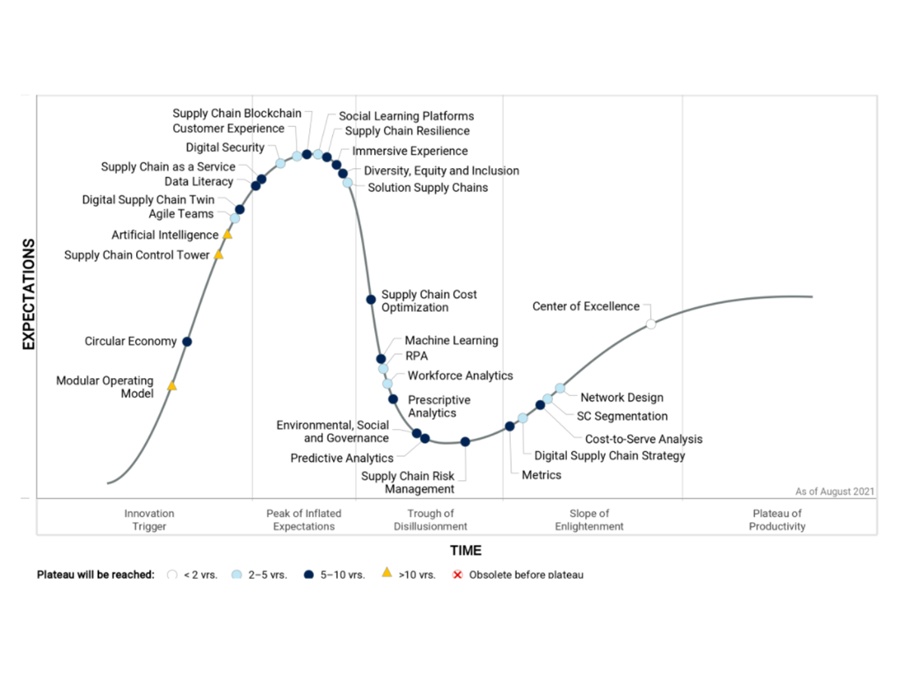
Visit Our Sponsors |
|
|
|
|
|
|
|
|
|
|
|
|
|
|
|
|
|
|
|
|
|
|
|
|
|
|
|
|
|
|
|
|
|
|
|
|
|
|
|
|
|
|
|
|
|
|
|
|
|
|
|
|
|
|
|
|
|
|
|

The supply chain “center of excellence” (CoE) has become widely adopted by supply chain organizations, while artificial intelligence will take years to reach maturity, according to the latest analysis from Gartner Inc.
Gartner analysts discussed capabilities from this year’s Hype Cycle for Supply Chain Strategy during the research company’s annual Supply Chain Symposium, being held virtually through Wednesday.
“In supply chain, at any point in time there are hundreds of competing initiatives and potential investment opportunities. It’s the CSCO’s job to invest in supply chain capabilities that will align with what the CEO wants the CSCO to prioritize,” said Noha Tohamy, distinguished vice president analyst with the Gartner Supply Chain practice.
Gartner surveyed 199 CEOs and senior business executives in supply-chain-intensive industries in 2020 and found that 17% of respondents see cost optimization as the top issue that CSCOs should focus on in the near future, followed by resilience.
“The Hype Cycle is a tool CSCOs can use to evaluate available options and decide how much to invest where. A nascent capability from the Innovation Trigger section should receive limited investments to run a pilot,” Tohamy said. “Then there might be underperforming capabilities from the bottom of the Hype Cycle that warrant reevaluation. CSCOs need to scale the solid, mature capabilities that have demonstrated consistent return on investment.”
Nascent Capability: AI
AI is a transformational capability that will still take some time to reach maturity, and is at the Innovation Trigger stage of the Hype Cycle. It applies advanced analysis and logic-based techniques, including machine learning (ML), to interpret events, support and automate decisions, and take actions.
“Given its transformation benefits, supply chain organizations should actively seek to understand the potential of AI and invest in small-scale pilots. Before any big investment decisions, supply chain leaders must be clear about organizational readiness, data and talent availability, and the role of AI in supporting supply chain and business priorities,” Tohamy said.
Evolving Capability: Supply Chain Risk Management
SCRM aims to make businesses resilient to supply chain risks across the physical and digital ecosystem. A comprehensive approach to SCRM focuses on the ability to identify and mitigate risks across the extended network footprint. It is strengthened by technology used for risk identification and monitoring, holistic risk impact analysis and coordinated operational mitigation.
In response to COVID-19, risk management has become front and center as companies needed to sense and respond to supply disruptions and shifts in business models. However, organizations have found that existing risk capabilities have largely been ineffective, and it is at the stage of the Trough of Disillusionment. Despite a major stake in managing risk, there is no clear owner of the process across supply chain functions.
“SCRM is a capability that many organizations have already invested in — but are now disillusioned as it didn’t fulfill expectations,” Tohamy said.
CSCOs must reexamine their SCRM strategy and make targeted investments that — for example — help balance the need for resilience with the goal of efficiency when designing a network or that constrains decision-making inputs to improve the quality and speed of decisions in case of a disruption.
Mature Capability: Supply Chain CoE
The supply chain CoE is a physical or virtual center of knowledge, concentrating on existing expertise and resources in a supply chain function, capability or process. CoEs operate adjacent to groups that execute core business functions. They find, design and implement changes to business processes, people or technologies. Gartner research indicates that almost 80% of supply chain organizations have one or more CoEs, indicating a high maturity, and it is at the stage of the Slope of Enlightenment.
“This is the stage where CSCOs can invest in scaling and expanding a capability,” Tohamy said. “Right now, most supply chain CoEs are focused on IT systems design and technology enablement, but only a few on talent development or change management. This is the next step that will enable the full potential of this capability.”
RELATED CONTENT
RELATED VIDEOS
Timely, incisive articles delivered directly to your inbox.


